
|
|
|
|
|
|
|
|
|
|
|
|
|
|
|
|
| Il Grigione Italiano – May 2, 2019 – by Paola Gianoli
|
|
|
|
|
|
|
|
|
|
|
|
|
|
Percorsi Musicali domenica 13 maggio 2018 by Ettore GarziaSono plurimi i motivi d’interesse utili per sondare la musica del batterista svizzero Sheldon Suter. Il primo è strettamente strumentale e riguarda la specialità dei rapporti con i partners: Suter ha costituito un suo progetto, il quartetto di Big Bold Back Bone, in cui ha sistemato l’operato di altri tre musicisti che hanno già una loro storia conclamata alle spalle; il trombettista Marco Von Orelli viene sfruttato nella parte più sperimentale del suo strumento, all’elettronica sintetica Sheldon si avvale di Travassos, musicista e design grafico riconoscibile per essere il creatore delle copertine di buona parte dei cds della Clean Feed, mentre l’altro portoghese è Luis Lopes, chitarrista anomalo, conosciuto per le sue collaborazioni con la crema dell’improvvisazione portoghese (Rodrigo Amado, Sei Miguel, etc.). 
Le modalità con cui scoprire Suter e i Big Bold Back Bone sono contenute nell’ascolto di due cds recentemente pubblicati dalla sussidiara della Clean Feed, l’etichetta shhpuma; si tratta di In search of the emerging species e di Emerge. La peculiarità di Suter sta nella cattura di una sorta di iper realismo surrettizio ricavabile dalle conformazioni musicali prodotte, in cui il ruolo del batterista perde peso a favore di una svolta verso specifici lidi dell’aggregato sonoro. In Search of the emerging species, le parti metalliche e percussive fanno sentire tutto il loro ardore, contribuendo alla creazione di suoni poltiglia, che potrebbero simulare molte cose; un’unica e lunga improvvisazione libera di 42 minuti, dal titolo programmatico (Immerge), vi trasporta in addensamenti neurali che l’immaginazione potrebbe classificare come ambasciatori di una realtà trasfigurata, dove ciò che si intuisce potrebbe essere una parte di un tutto (è un’analisi che può essere fatta seguendo un canone di riconoscimento per suoni che proiettano il cinguettio degli uccelli oppure ferri a vapore che vengono fatti scaricare). C’è una confluenza della parte attribuita a ciascun musicista, una ricerca di suoni organizzata per imporre condensazioni sonore sugli oggetti e nei contatti, dove la tecnica estensiva la fa da padrona e la movimentazione, con dinamiche più o meno fascinose, regge costantemente in tensione. Si potrebbe dire che la visione musicale è portata ad un confine incredibilmente non netto tra propensione naturalistica e concretezza.
In Emerge le percussioni rivelano un suono granitico e la progressione ritmica è acusticamente vicina all’effetto di un chiudersi di porte, una pluralità che si accompagna ad una sorta di sfasamento implicito dell’impianto libero profuso dai quattro musicisti. Lopes (con distorsioni e linee singole), Travassos (con il compattamento dell’ambiente sonoro) e Von Orelli (quasi sempre in accento deformativo) lavorano su una sorta di surrealismo sonoro che ha le sue connotazioni e le sue attitudini. E’ così che la lezione di Varese non è la sola presente in Facing extinction, dove un climax disturbato accoglie una selva di suoni sodomizzati effettuati su corda o su percussioni, di contro ad una tromba che strepita, polemizza o denuncia. Il rapporto di vicinanza a Miles Davis è confuso, così come sorprendenti sono l’impianto ritmico di Tentaculita, che nasconde un’aderenza quasi punk o il drumming giocato da Sheldon su tamburo o rullante in Ground Found, un “su di giri” che sembra fare brutte previsioni e dove la tromba di Von Orelli segnala pazzia ed acidità.
Non è causale fare un riferimento ai disegni di Travassos, che da più parti vengono considerati slegati dal contenuto musicale; in realtà l’aspetto kafkiano delle copertine, che ritraggono disegni di animali o uomini fantasticamente ricomposti, accetta la prospettiva naturalistica di Sheldon e dei suoi musicisti, una forma di coesistenza tra il reale e il visionario, che è un misto di semplicità, irrazionalità, banalità o ritorno al ricordo fanciullesco, che in molti vedono come il vero insegnamento dell’umanità. Trovare un’equilibrio di pensiero e di comportamento nelle varie combinazioni degli aspetti complessi o semplici della vita. |
| 3/5/2018 – http://www.sands-zine.com/recensioni.php?IDrec=2172#
Big Bold Back Bone: si tratta di un quartetto misto svizzero (il batterista Sheldon Suter e il trombettista Marco von Orelli) portoghese (il chitarrista Luis Lopes e il manipolatore elettroacustico Jorge Trindade, in arte Travassos, quest’ultimo è anche il grafico della Clean Feed. “Emerge” è il terzo disco dell’ensemble e fa seguito a un altro CD su Wide Ear Records e a un lavoro gemello pubblicato su Shhpuma (sussidiaria della Clean Feed). La musica è un eccelso connubio fra improvvisazioni jazz ed elettroacustiche. |
| April 18th 2018 / –> Chain D.L.K.
The idea that a record can be the anti-epos of another one is quite fascinating and interesting. According to the description by the artists-run Wide Ear label, “Emerge” could be considered so against its musical twin “In Search Of The Emerging Species” (released by Portuguese label Shhpuma). Both of them got recorded in the same studio session in Lisbon and they last the same time (approximately 43 minutes), even if the latter featured only one immersive track (titled “Immerse”), while “Emerge”‘s length has been split into seven shorter tracks. I only listened to some parts of “In Search Of The Emerging Species”, and to be honest, the approach to the sound of “Emerge” sounds quite similar to me, in spite of the above mentioned differences. Both of them have been filled by drone-like sonic streams, roughly structured and performed in a way that could let you think the four members of Big Bold Back Bone (Marco von Orelli on trumpet and slide trumpet, Sheldon Suter on prepared drums, Luis Lopes on electric guitar and other objects, and Travassos on electronics) never played their instruments before, as if they were mysterious artifacts they found on the bottom of the depths they explored during their search for emerging species. The amalgamation they made often sounds like an easy debriding of fibrous tissues, where just some instrumental elements seem to have been completely resurfaced (Marco’s trumpet on “Silent Stream” or “Tidings” or some shell-like percussions on “Sealust”). Electronics and percussions sometimes evoke the removal of water or air infiltration of some submarine vehicle after an immersion and can mirror other mysterious technical maintenance following an immersion and any related issue. If you consider this record in this way, you can also explain the reason why the last track “Ground Found” is the one which sounds more vaguely musical of this gradual surfacing. |
Bad Alchemy 98 by Rigobert Dittmann, April 6th 18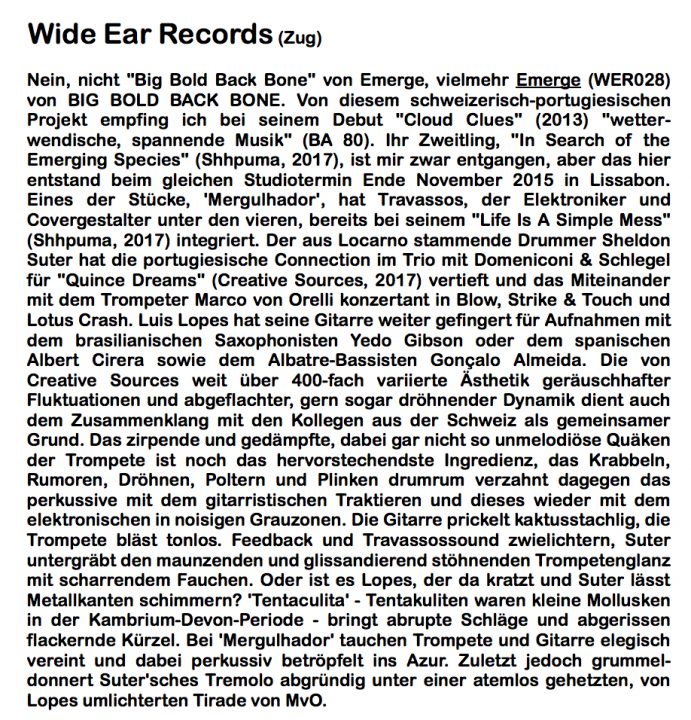 |
|
JazzFlits Nr. 295 / 2. April 2018 / Herman te Loo |
|
26.2.18 Gin & Platonic Big Bold Back Bone – Emerge Jaké to asi je, ocitnout se na jiné planetě a najít předměty, jejichž účel je vám naprosto neznámý? Nejspíš takové artefakty ohmatáte, zkusíte s nimi manipulovat, ale jejich funkční mechanismus vám pravděpodobně zůstane navždy utajen. Přesto se však můžete dobrat zajímavého výsledku. Asi takhle přistupují Big Bold Black Bone ke svým nástrojům. Emerge je vlastně dvojčetem loňské skvělé a radikální desky In Search of the Emerging Species. Obě nahrávky vznikly během lisabonské session v listopadu 2015. Na obou hrají čtyři muzikanti – Marco von Orelli (trubka), Luis Lopes (kytara a objekty), Travassos (elektronika), Sheldon Suter (preparované bicí) – kteří prozkoumávají hranice toho, jak ještě lze hudební nástroj použít. Povědomé zvuky se objeví jen párkrát, o to silněji však zarezonují. Jako když někde tam daleko ve vesmíru zahlédnete známou tvář. V okamžiku je ale pryč a vy zas musíte putovat neznámou krajinou. Nějak tak by zřejmě zněly i field recordings z podobného místa. „Přírodní a industriální“ zvuky a textury do sebe prosakují, reagují spolu a tvoří stále novou sonickou hmotu – jen se jí poddat a nechat se pohltit. Letošní Emerge je oproti předchůdci přístupnější. Pokud lze v tomto případě užívat tyto pojmy, je daleko melodičtější a rytmičtější, mnohem méně pracuje s tichem a také má jasně oddělené části. Zkrátka popík jak vyšitý… teda, pokud jste stále na té cizí planetě. ©siderorea |
|
O quarteto Big Bold Back Bone resulta de uma parceria luso-suíça, juntando dois músicos suíços e dois portugueses (Luís Lopes e Travassos). Os suíços Marco Von Orelli (trompete) e Sheldon Suter (bateria) consistem no duo Lost Socks, grupo que trabalha a improvisação a partir de uma matriz de origem jazzística.
Do lado português, o versátil guitarrista Luís Lopes vem alimentando um percurso cada vez mais rico e, entre outros, lidera os grupos Humanization Quartet (com Rodrigo Amado), Lisboa-Berlin Trio, Afterfall, trio com Adam Lane e Igal Foni, duo com Fred Lonberg-Holm, além de um registos a solo (“Noise Solo at ZDB” e “Love Song”). E Travassos é, além de reconhecido designer (atenção ao livro “Life is a simple mess”), um criativo manipulador de electrónica analógica, num percurso musical que tem atravessado múltiplos projectos: FLU, Pinkdraft, Les Voisins, One Eye Project e Pão – com Tiago Sousa e Pedro Sousa, que terá sido um dos mais originais projectos nacionais dos últimos anos. O grupo Big Bold Back Bone nasceu no ano de 2010, altura em que se apresentou ao vivo para os primeiros concertos, e em 2013 editou o seu disco de estreia, “Clouds Clues” (edição Wide Ear). Chega agora o segundo disco do quarteto, desta vez numa edição da Shhpuma, a subsidiária da Clean Feed para projectos mais experimentais/exploratórios. Neste novo “In Search of the Emerging Species”, gravado em Novembro de 2015, o quarteto desenvolve uma improvisação electro-acústica num trabalho de detalhe e pormenor, que se aproxima de um certo reducionismo/near silence. Os músicos optam sempre por uma postura de assumida contenção, daqui resultando uma música de atenção ao milímetro. O disco consiste numa faixa única de 43 minutos, onde os quatro músicos articulam um diálogo quase sussurrado. Esqueça-se a expansividade, não há aqui gritos de raiva, cada instrumento intervém de forma controlada, contribuindo com intervenções minimais. Guitarra, trompete, bateria e eletrónica entrelaçam-se numa música delicada que evolui tranquilamente, electro-acústica que vive na permanente subtileza. |
| Freistiel #78
|
|
|
|
|
|
|
|
|
|
|
|
|
|
|
|
|
|
August 2017, by Derek Stone How does one come to appreciate, let alone enjoy, a new genre of music? Despite the cries that ring out from some musical essentialists, it is my belief that the enjoyment of new, as yet un-grappled-with types of expression can be developed. As many of the writers and perusers of this site will tell you, a love of free jazz didn’t just spring out of the soil one happy day – it took considerable time and effort, an investment of interest and a willingness to occasionally put oneself at the mercy of tones, timbres and textures that were often downright ugly. But soon, the effort paid off; familiarity helped round the edges, so to speak, and the oblique, forbidding architecture that makes up so much of free jazz began to slope and curl its way into shapes that could arrest us, captivate us, leave us foaming at the mouth in anticipation of more. The critical viewpoint played its role as well. While much of free jazz is seemingly senseless on first listen, the astute observations of many a free jazz critic were instrumental in giving us a foothold, so to speak – by fixing a grid atop the swirling chaos, we suddenly had some coordinates with which to find our place. The development of enjoyment doesn’t just move in one direction, either; doubtlessly, some of our readership started with the strong stuff, imbibing Sun Ra, Coleman, or late-period Coltrane before eventually working their way back through the ‘60s and ‘50s to arrive, like battle-hardened generals returning to the scene of the first fight, at the earliest jazz recordings of the ‘30s and ‘40s. And, once again, enjoyment didn’t just spring up. After a diet of fiery, intense free improvisation, the bouncing sounds of Duke Ellington and His Orchestra are like another planet, with all of the dread and uncertainty that that implies. The reason I make this preamble is that I, personally, have not yet found a good entry-point into electro-acoustic improvisation (often simply called EAI). While I’ve been exposed to a fair number of the genre’s respresentative recordings, there has been nothing to grab me and give me that “aha!” moment – that split second when everything falls into place and the sounds begin, little by little, to open up and make themselves known. Big Bold Back Bone’s debut on Clean Feed, In Search of the Emerging Species, while not explicitly an EAI record, has enough stylistic overlap with the genre to have been a cause for concern for me – would I have anything meaningful to say about it? Would it just be wind in my ear? In any case, I decided that the path to enjoyment had to start somewhere, and it may as well start here. A quartet, Big Bold Back Bone features Marco von Orelli on trumpet and slide trumpet, Sheldon Suter on prepared drums, Luis Lopes on electric guitar and other objects, and Travassos on electronics. One thing to note when going into this recording, however, is that Big Bold Back Bone approach their instruments in the same way that I once heard Derek Bailey approached his guitar – as an alien artifact, a found object without context or connotation, a tool with which one could experiment freely. As such, the focus here is not on making “music” in the traditional sense of the word, but on exploring the sounds that can be constructed when a certain group of people come together at a certain time, in a certain room, with certain instruments and objects at their disposal. As the title suggests, In Search of the Exploring Species is an investigation of possibilities, a circuitous trek, rather than a direct route to some predetermined destination. At an unbroken 43 minutes, it might be feared that the sole piece here, “Immerge,” is a slog to get through, but that’s not true at all. If anything, because of the lightness (volume-wise) of the textures and the relative lack of structured movement, it seems to speed by. It opens with a tentative series of knocks from Suter’s kit, some hard-to-pinpoint rubbery scrapes, von Orelli’s metallic gurgles, and the softly roiling static of Lopes’s electric guitar. Meanwhile, Travassos provides some high-pitched tones that, due to their relative faintness, fall somewhere between bird-song and the whine of drills. From this initial setting, deviations seem to occur in imperceptible waves – notably, von Orelli treats his trumpet as an open canvas of sorts, extracting all manner of timbres from its body: hollow sussurations, watery burbles, dry crackles. At some point, Suter moves from the more forceful pops and taps of the opening to cymbal-work that casts an uneasy shadow over the entire piece, and Travassos follows suit with cavernous electronics that open up the bottom and threaten to submerge everything. Lopes is ever-subtle, preferring to use his guitar as a textural device – from staticky drones to unsteady scrapes, he’s continuously in service of the overall tone of the piece. In fact, one of my abiding impressions of “Immerge” is that no single player seems to dominate the proceedings; in the spirit of the best free improvisation, the individual sounds bleed into each other, mixing and melding in ways that help to elevate the whole. Interestingly, the final ten minutes of the track find some of the musicians getting close to something that might be called “traditional music-making.” Lopes produces open notes that ring out with astounding clarity after the muffled drones of the preceding half-hour, and von Orelli emits a series of, well, trumpet-like tones. Suter engages in glacial, abstract percussion-work, and Travassos murmurs quietly in the background, a constant presence that never makes itself unduly felt. By the time “Immerge” comes to a close, I feel that I have gotten ever closer to understanding the world of electro-acoustic improvisation – if I’m not yet putting every release from the Erstwhile label in my Discogs shopping cart, I’m at least considering the possibility. At a brisk 43 minutes, and with a variety of textures and sounds to keep your ears busy, In Search of the Exploring Species is a better place than any to get started on a new journey of musical enjoyment. And as a selfish addendum – feel free to post recommendations for more of this type of music in the comments below! |
 |
| By Shaking the Squid, May 23, 2017 – the Squid’s Ear
Swiss trumpeter Marco Von Orelli leads this trio with Max E. Keller on piano and Sheldon Suter on drums, heard live at JazzAmMittwoch, Theater an Gleis, in Winterthur, Switzerland in 2014 for a thoroughly modern jazz outing of creative and extended approaches to the trio’s instruments and approach to free jazz. If you haven’t heard Von Orelli play and you’re a fan of the most modern approaches to playing, as exemplified in musicians like Nate Wooley or Axel Dorner, you need to check this guy out, as his range and palette of approaches is both startling and compelling. |
| Jazz’n’More (Mai/Juni Nr.3/2017)
|
| … Marco von Orelli, Max E. Keller, Sheldon Suter: Blow, Strike & Touch. Hatology 732.
Auf der Weltkarte des Jazz ist die Schweiz ein wichtiger Ort – nicht zuletzt, weil mehrere namhafte unabhängige Labels hier zu Hause sind. Eines von ihnen ist das 1975 von Werner X. Uehlinger gegründete, in Basel ansässige Unternehmen HatHut Records, das hauptsächlich im Bereich der freien Improvisation und der Avantgarde tätig ist… Auch in diesem Frühjahr präsentiert das Label sowohl packende Neuerscheinungen als auch Klassiker der Moderne. Zur HatHut-Familie zählt auch der immer noch junge Schweizer Trompeter Marco von Orelli. Der Basler hat schon mit seinem Debüt «Close Ties on Hidden Lanes» (2012) überzeugt. Auf seiner neuen CD präsentiert er sich im Trio mit dem Pianisten Max E. Keller und dem Schlagzeuger Sheldon Suter. Auch hier geht es um Improvisation, um ein Gespräch auf Augenhöhe. Aufgenommen wurde das Konzert am 2. April 2014 im Theater am Gleis in Winterthur. Fazit: Der Free Jazz lebt. Nicht zuletzt dank Werner X. Uehlinger. Chapeau! Manfred Papst, NZZ am Sonntag, 16.4.2017 |
Manfred Papst, NZZ am Sonntag, 16.4.2017

|
Jazz’n’More – #2/17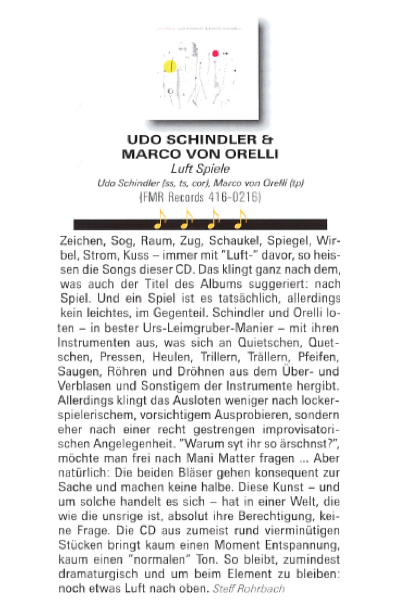 |
Luft.Spiele ist ein Veröffentlichung des deutschen Musikers und Architekten Udo Schindler aus Krailling bei München, in diesem Fall mit dem Schweizer Trompeter Marco von Orelli. Das Album besteht aus neun Nummern, die meist um die vier Minuten andauern und sich dem Element Luft von diversen Seiten nähert. LUFTzeichen, LUFTsog, LUFTtraum, so die ersten drei Titel dieser Veröffentlichung. Die Gesamterscheinung dieser CD ist sehr stimmig mit passendem Layout und ergänzendem Begleittext des Musikers Omri Ziegele. Er befasst sich darin assoziativ mit dem Thema Luft. Die zu hörenden Aufnahmen entstanden im Rahmen eines Konzerts, welches im September 2015 im „Salon für Klang und Kunst“ in Krailling stattfand. Sehr dicht ist die Musik, die einem hier begegnet. Luftgeräusche selbst in Form von purem Rauschen gibt es nicht zu hören. Man begegnet hier eher expressiven Klangäußerungen im Duo sowie geräuschaffinem Spiel auf den jeweiligen Instrumenten. Die Musiker befinden sich in einem steten Dialog miteinander. Hier wird ohne viel Firlefanz für den Moment musiziert, und zum Anhören ist das recht kurzweilig. (kat)freiStil Magazin für Musik und Umgebung |
UDO SCHINDLER & MARCO VON ORELLI – Luft.Spiele (FMR 416; UK), by Bruce Lee Gallanter Featuring Udo Schindler on sopranino & tenor saxes & cornet and Marco Von Orelli on trumpet.The great FMR label continues to present a wealth of gifted musicians from different scenes. German reedman, Udo Schindler appeared on another newer duo CD from FMR with fellow saxist Frank Paul Schubert. Swiss trumpeter, Marco Von Orelli, has two fine more recent discs out on Hatology. This disc was recorded live in Munich, Germany) in September of 2015. These two players seem well matched, spinning quick lines around one another, from fast & furious to slow & assured. Both men take their time to explore, bending and twisting notes carefully. The song titles all start with ‘Luft’ and deals with terminology which is involved with wind, like suction or airspace. Midway, the duo slow down for some more contemplative dialogue, which is calm yet somehow fascinating. They eventual move into soft, steaming radiator sounds which were popular with Erstwhile trumpeters Axel Dorner & Frantz Hautzinger for a short while. A rather striking, intense and unsettling duo that shouldn’t be ignored.Bruce Lee Gallanter, DMG |
| Bad Alchemy Magazin (BA 92) – by Rigobert Dittmann
UDO SCHINDLER & MARCO VON ORELLI Luft.Spiele (FMR Records, FMRCD416-0216): Mit allen Raffinessen, die sich nur denken lassen, saugen, zerren, schaukeln, wirbeln, |
| MARCO VON ORELLI 5, ALLURING PROSPECT by citizenjazz
Si Close Ties on Hidden Lanes, son précédent disque en sextet chez HatHut, en disait long sur Cette baisse d’effectif n’est pas qu’une simple réduction de voilure ; en se passant de la clarinette basse On retrouve également la complémentarité de ce noyau dur sur le très abstrait « Triptychon » par // Publié le 24 avril 2016 |
Mitreißende Jazzmusik in Klosterkirche Am Saxofon Udo Schindler, Günther Baby Sommer am Schlagzeug und Marco von Orelli an der Trompete. Giesen
© OVB, 30.3.2016
… Am letzten Abend gab es ein furioses Finale mit allen Musikern, das am Ende mit „Summertime“ nach Gershwin gekrönt wurde. |
Marco von Orelli 5: Alluring Prospect* * * * Teniamo d’occhio da un po’ di anni lo svizzero (di Basilea, per l’esattezza) Marco von Orelli, Quest’ultimo lavoro in quintetto (formazione minima, diremmo, per dar voce alle sue doti di autore Vi si ritrova quel fare vagamente cameristico che da sempre contraddistingue la musica di Orelli, Ci sono episodi solitari (proprio la tromba di Orelli nell’iniziale “Prolog—Lisboa Day,” Track Listing: Prolog – Lisboa Days; Ayako; Monte Verità; Ghost Dance; Triptychon; Boat People; Vita. Personnel: Marco von Orelli: tromba; Lukas Briggen: trombone; Michel Wintsch: pianoforte, sintetizzatore; Year Released: 2015 | Record Label: Hatology |
|
Marco von Orelli 5, Alluring Prospect by hatOLOGY 726 February 21, 2016 Downsizing obviously isn’t an expletive for Basel-based trumpeter Marco von Orelli since he keeps Before tuning this into a tract on numerology the explanation is that part of the appeal of Alluring Prospect The rasping riffing that characterizes the Briggen-von Orelli partnership however is expressed throughout; Instructively von Orelli extends this EuroJazz concept even further. Matching machine oscillations and trumpet Von Orelli’s modulations and motivations coupled with the others’ playing confirm why listening to this CD is in itself an alluring prospect. The added anticipation rests in wondering at what size the group will next record and what it will produce. —Ken Waxman for JazzWord |
|

Marco von Orelli 5: “Alluring Prospect” (Hatology) O trompetista suíço Marco von Orelli tem uma ligação a Portugal, e esta ganhou expressão como Se os luso-transalpinos BBBB optam liminarmente pela improvisação, a escrita é neste disco o eixo e o |
|
Big Bold Back Bone 30 de Novembro de 2015 Viagem de automóvelO quarteto de Marco Von Orelli, Luís Lopes, Travassos e Sheldon Suter apresentou na Parede a sua visão Há uma anedota, criada pelos próprios suíços para se rirem de si mesmos, em que um casal do país dos Marco Von Orelli, Luís Lopes, Travassos e Sheldon Suter têm como coordenadas musicais a reiteração de Mas assim como é verdade que mesmo numa música dita “não-desenvolvimentista” há movimento, com Acresce que os Big Bold Back Bone têm na EAI apenas os fundamentos. As bases de sustentação podem ser as texturas abstractas e o “bruitismo” dessa tendência, mas a esse plano adicionam melodia, harmonia e ritmo, os alicerces da musicalidade tal como é convencionalmente entendida, ainda que os fraseados melódicos surjam fragmentados, as construções harmónicas se pretendam imediatistas e a pulsação seja quebrada, polirrítmica ou arrítmica. É desse lado que vem o jazz, muito centrado no trabalho do trompete (e do trompete de vara) de Marco Von-Orelli. Se neste concerto o ouvimos a partilhar os burburismos de Axel Dörner, também nos remeteu para a sonoridade quente de um Don Cherry, a doçura de um Miles Davis e até a languidez de um Kenny Wheeler. Notou-se, no entanto, um desequilíbrio entre os préstimos dos dois suíços e as contribuições dos dois portugueses, e esse problema fez com que sentíssemos que estávamos não diante de um quarteto, mas de dois duos – o que não se verifica no (excelente) disco lançado em 2013 pelo projecto, “Clouds Clues”, e não se detectou nas poucas anteriores apresentações ao vivo no nosso país. Os Big Bold Back Bone têm uma existência intermitente. Só muito de vez em quando os quatro músicos se reúnem, e a última vez em que isso se verificou foi para uma digressão pela Suíça no passado mês de Maio. Ora, Von-Orelli e Suter mantêm com regularidade um dueto, Lost Socks (tocou dia 27 no Creative Fest), e ficou bem patente o entrosamento que têm entre si, deixando inevitavelmente os outros parceiros Ou seja, se os suíços conquistaram os seus próprios espaços de projecção num contexto que era iminentemente colectivo, com magníficos solos de Von-Orelli e uma notável e muito imaginativa prestação do baterista e percussionista, Luís Lopes e Travassos mantiveram-se algo passivos. Na maior parte do tempo limitando-se a torturar as cordas da guitarra com um arco de violoncelo, Lopes dispensou-se de dar ao público o que tem de melhor e que contribuiria, decerto, para enriquecer a música e colocar-se ao mesmo nível da dupla suíça. Os resultados foram ainda assim bastante interessantes, mas poderiam ter sido magníficos e a esse tipo de enlevo infelizmente nunca se chegou. Como respondeu a esposa da anedota à questão do seu cônjuge: «Foi bom, sim, querido. Temos de fazer outra vez, e melhor.» Aguardemos, para daqui a alguns quilómetros… |
|
Net als het bergpad op de hoes zit de muziek van de Zwitserse trompettist vol verraderlijkheden. oktober 27, 2015, Mischa Andriessen |
| AZ München, 15.10.15
|
Festival Report – Météo, Mulhouse (F) By Ken Waxman… Evans wasn’t the only impressive trumpeter either. Marco Von Orelli playing with fellow Swiss, drummer Samuel Dühsler and bassist Kasper Von Grünigen opened the festival with an afternoon set at the Mulhouse tourist office. Mercurial but motivated, the three easily dealt with supposedly limited tones by dividing up the program as if they were actors playing multiple roles. Besides keeping up a solid rhythmic thrust, the bassist stepped forward for below-the-bridge swipes and guitar-like snaps, while the drummer animated his processes with clattering cymbals and wood-block smacks. Picking up on the trumpeter’s insouciant buzzes and flutter-tonguing, they twisted accompaniment into logical tune extensions. Biting or bucolic, the perfectly matched trio members’ set confirmed there are plenty of younger players who deserve exposure. And it’s this impulse as well as providing a showcase for mature stylists that allow festivals such as Météo exist and thrive.—For The New York City Jazz Record October 2015 |
|
ALLURING PROSPECT Entre écriture et improvisation. Marco Von Orelli le petit dernier lancé par le label de référence Hatology. Enregistré au Studio Namouche à Lisbonne, du 19 au 22 février 2013. |
|
Títol: Alluring Prospects Músic, compositor i improvisador. El trompetista suís Marco von Orelli continua presentant projectes de gran nivell 29 setembre, 2015 per Marçal Borotau a Hat Hut Records |
Basellandschaftliche Zeitung, 15. Juni 15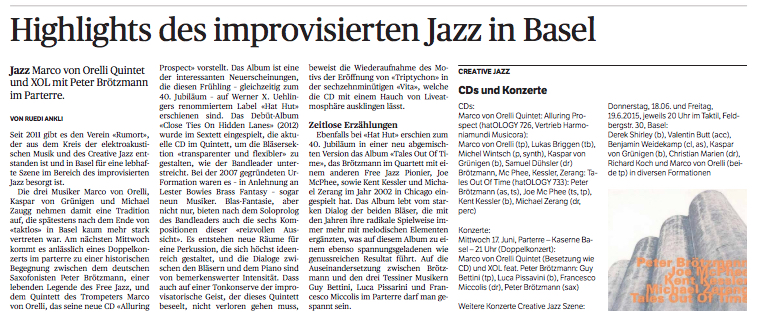 |
Jazzpodium – Juni 2015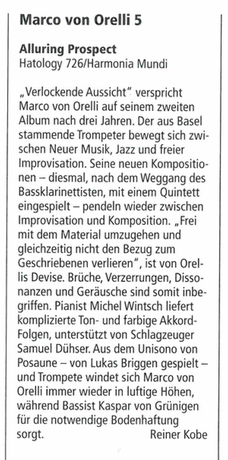 |
| Jazz’n’More Nr. 3 – 2015
|
| Weltwoche Nr. 17 – 23. April 2015 von Peter Rüedi  |
NZZ am Sonntag – 19. April 2015 Jazz Kompromisslos Marco von Orelli 5: Alluring Prospect. Hat Hut Records 726.Der junge Trompeter und Komponist Marco von Orelli ist uns 2012 erstmals aufgefallen. Der aus Basel stammende Musiker, der in Winterthur, Zürich und seiner Heimatstadt studiert hat, publizierte damals auf Hat Hut sein Debütalbum «Close Ties on Hidden Lanes». Die Sextett-Aufnahme bewegte sich zwischen Jazz, Neuer Musik und freier Improvisation. Das Erbe von Ellington und Mingus war so präsent wie die Zwölftonmusik. In verschiedenen Formationen hatte der Trompeter bereits zuvor sein Talent bewiesen: in der Big Band von George Gruntz etwa, aber auch in Tommy Meiers «Root Down». Nun legt er sein zweites Album als Leader vor. Aus dem Sextett ist ein Quintett geworden. Ausgeschieden ist der Bassklarinettist Lukas Roos. Auf den übrigen Positionen ist alles beim Alten: Lukas Briggen spielt Posaune, Michel Wintsch Klavier, Kaspar von Grünigen Bass und Samuel Dühsler Schlagzeug. Die Kompositionen – fünf von sieben hat der Leader selbst geschrieben – sind kompakter geworden. Sie reflektieren Erlebnisse und Bildungsgut der Musiker – von Katzen über Geister bis zum Monte Verità -, sind aber nicht Programmmusik im engen Sinn. Kompromisse an den Publikumsgeschmack werden keine gemacht. Es geht um Exerzitien, nicht um Kulinarik. Hübsche Vignette: Peter Margasak behauptet im Booklet zur CD keck, «Triptychon» sei Schweizerdeutsch für «Triptych». (pap.) |
|
Marco von Orelli 5: Alluring Prospect (2015), hatOLOGY 726 **** By GLENN ASTARITA, Published: April 9, 2015
Swiss trumpeter Marco von Orelli possesses a manifold musical persona. He’s composed for TV, theater and collaborates with many notable European jazz artists and improvisers. But as a leader, Alluring Prospects poses deep insight into his enthralling compositional pen, bridging classical, jazz and the improvisational element into multilateral array of largely, energizing frameworks. Track Listing: |
 |
IMPRO JAZZ Magazine d’information musicale No. 211 – janvier 2015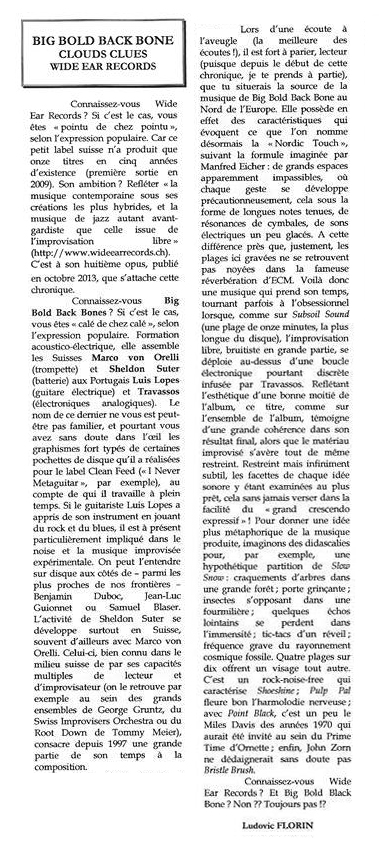 |
| Big Bold Back Bone – Clouds Clues (Wide Ear Records)
Guy Peters – 08 december 2014 – www.enola.be 
Opnieuw een release die in Lissabon (maar wel al in 2010) werd opgenomen |
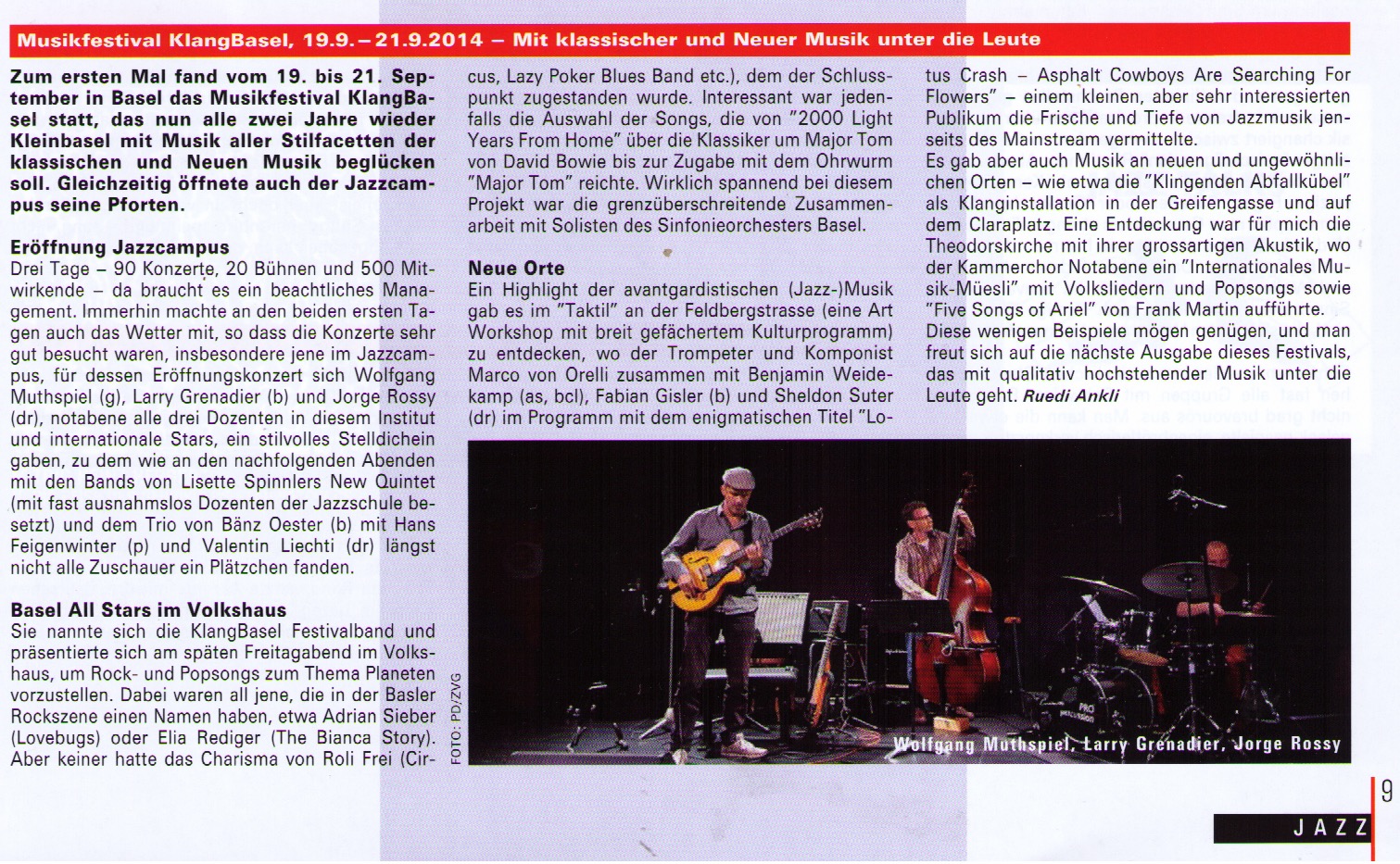 |

Dans cette station de télescopage qu’est Big Bold Back Bone s’agitent quelques familiarités (un zeste de Prime Time ici, un zeste de Berne–Ducret ailleurs, des sursauts soniques un peu partout). Y stagnent aussi des terres introspectives, logiquement malaxées par les analogic electronics (des electronics bio ?) de Travassos. |
| vital weekly – number 931 ——————— week 19 http://www.vitalweekly.net/931.html Wide Ear Records is a new Swiss label for contemporary music in all its possible crossovers. Swiss-Portuguese collaboration Big Bold Back Bone is a first example of this. A quartet made up of Marco von Orelli (trumpet, piccolo trumpet), Louis Lopes (electric guitar), Travassos (analogue electronics) and Sheldon Suter (drums). A first one off meeting in 2008 turned out to be the starting point for further collaboration. After a short tour through Portugal they decided to make some recordings in a Lisbon studio in December 2010. It are these recordings we find on this release. Some background. Von Orelli and Suter are both member of Musique Brute, a Swiss improv combo who released an album (‘Poste Restante’) on Unit Records in 2012. Travassos is educated in the field of design, setting his first steps as a musician here. Lopes is often met in the company of musicians like Sei Miguel, Stefan Gonzalez, a.o, and leads his own project Humanization Quartet. As the recordings for‘ Cloud Clues’ date from several years ago, I hope the four are still in business as Big Bold Back Bone. Their – often – noisy sound improvisations sound very together and focused, playing with lots of ideas. Lively and really exciting improvisations it are, not in the least by the subtle electronics of Travassos. Address: http://www.wideearrecords.com |
| Jazz’n’More no. 2/2014
|
Sun Ship 17 Janvier 2014 Big Bold Back Bone – Clouds Clues Fruit de la rencontre de musiciens suisse et de musiciens portugais autour d’un jeune label helvète prometteur, Wide Ear Records, Big Bold Back Bone (BBBB) est un quartet dirigé par le trompettiste Marco von Orelli, que l’on avait pu repérer au sein du Root Down de Tommy Meier, et surtout à la tête d’un sextet qui a publié un album chez Hat-Hut en 2012. Musicien de l’instant, von Orelli aime l’urgence et la chaleur. A ses côtés, on retrouve son compatriote Sheldon Suter qui partageait déjà avec lui le bien nommé Musique Brute où l’on retrouvait également Co Streiff dans un exercice assez proche de celui qui nous concerne aujourd’hui. Les techniques étendues du trompettiste, souvent sur le fil du simple souffle, trouvent avec son batteur un percussionniste sensible, très organique. Suter sait accompagner l’improvisation vers des plages de calme comme dans des brisures soudaines et nerveuses sans cependant renverser la table. Parfois, au fil de l’album, on songe à Kaze par cette urgence pleine de raffinement où la trompette est un pivot fragile (“Nice Drive”, qui ouvre l’album). Dans un morceau comme “Outdrops Boat”, son jeu très métallique borde une vaste masse sonore pleine de chimères et d’échos lointains. Cet espace d’apparence infini est le terrain de jeu de BBBB. C’est cette impression d’espace qui définit Cloud Clues, le premier album de BBBB. Il permet de découvrir une musique sèche, nerveuse et percluse d’électricité où la trompette de von Orelli est travaillée en son coeur par la guitare omniprésente de Luis Lopes, qui s’affirme d’albums en albums comme l’un des guitaristes actuels préféré de ces pages. Que ce soit au sein de son Humanization 4tet ou dans le remarquable Lisbon Berlin Trio, l’approche à la fois pleine de souffle et de tension, proche de la rythmique et très bruitiste du guitariste assèche au possible le propos de ses comparses. Il suffit de se plonger ici au coeur de l’incendiaire “Shoeshine” pour s’en rendre compte ; le jeu d’embouchure du trompettiste est giflé par de grands riffs monochromes de guitare, comme une nuit qui se crèverait pour laisser paraître une lumière éclatante, brute et cireuse. Le jeu de Lopes est acrimonieux, rageur parfois, mais il n’a pas la virulence que l’on avait pu rencontrer dans son dernier live. La présence de Travassos, architecte du son qui contribue également (on a jamais assez de talent) à l’identité graphique de Clean Feed Records y contribue grandement. Ce dernier a également joué de son électronique fébrile aux côtés de Rodrigo Amado ou Heddy Boubaker. C’est lui qui, en travaillant le son de ses comparses en direct, en jouant avec la répétition des timbres et leur extension irréelle, crée cette impression nébuleuse, cotonneuse et sépulcrale que l’on retrouve dans un morceau comme “Horizon Flicker”, qui clôt l’album. Le titre de l’album et sa pochette céleste laissent d’ailleurs un doute dans cette nuit aux lumières hésitantes; est il question de nuages ou de brouillage ? Un peu des deux, manifestement. Tout est l’oeuvre de Travassos, qui explore avec bonheur cette musique de nuit. Dans le central “Subsoil Sound” qui permet de croiser les éclats de la trompette et les griffures méthodiques de la guitare, le sculpteur de son s’empare d’un claquement d’embouchure pour en faire le cri répété d’un oiseau. On se téléporte alors dans un monde inquiétant, infectieux et touffu où une trompette nerveuse semble sortir d’une clairière pour se jeter dans un flot d’électricité qui semble gonfler à mesure que le morceau avance. Cloud Clues est un album tourmenté, balayé par le vent créatif qui traverse depuis plusieurs années le jazz européen, pas si éloigné des improvisations nébuleuses de Christoph Erb au sein de Veto Records. Il nous accompagne avec agilité sur le fil ténu entre rêve et cauchemar dans les ténèbres tumultueuses de l’improvisation. C’est peu dire qu’on aime à s’y perdre.. |
Big Bold Back Bone: “Clouds Clues” (Wide Ear Records)
|
Big Bold Back Bone – Clouds Clues (by Wide Ear Rec.) · 23 Out 2013 Uma espinha dorsal luso-suíça.
Reunindo uma formação instrumental atípica, o quarteto Big Bold Back Bone resulta de uma parceria luso-suíça. Do lado nacional estão os representantes Luís Lopes, na guitarra eléctrica, e Travassos, na eletrónica analógica. A dupla portuguesa confronta-se com a dupla suíça: Marco von Orelli no trompete e Sheldon Suter na bateria. Os suíços constituem o duo Lost Socks (dedicado à improvisação), o guitarrista Luís Lopes o lidera o grupo Humanization Quartet (com Rodrigo Amado) e Travassos explana a sua electrónica analógica em múltiplos projectos (refira-se o trio Pão, entre outros projectos). Registada em Dezembro de 2010, na sequência de alguns concertos que o quarteto organizou em Portugal, esta música mantém agora toda a actualidade e frescura. Assente na improvisação, esta é uma música que vive da interação instrumental que, estranhamente, funciona de forma muito fluída. O trompete de von Orelli revela uma imaginação controlada, a percussão de Sheldon sabe estar presente (sem ser pesada), a guitarra de Lopes nunca é excessiva (mesmo nos momentos de maior vertigem) e a electrónica de Travassos complementa com equilíbrio. Democrática e estável, esta música é simultaneamente inventiva e muito aberta. Sem se fixar num rótulo definitivo, o quarteto vai-se esquivando entre laivos de jazz, electro-acústica e, no limite, rock. Mas é na improvisação que assenta o seu vector fundamental, é daí que é alimentada uma permanente tensão, combustível para uma música curiosa e fervilhante. Entre a eficiência suíça e o desenrasque lusitano, Clouds Clues é uma óptima surpresa. Nuno Catarino |
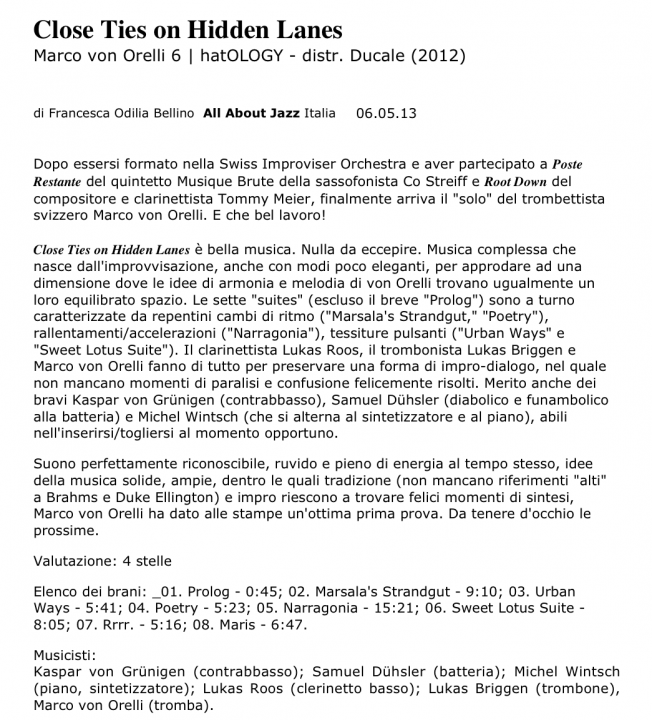
|
| by Peter Margasak in DownBeat Magazin, January 2013
|
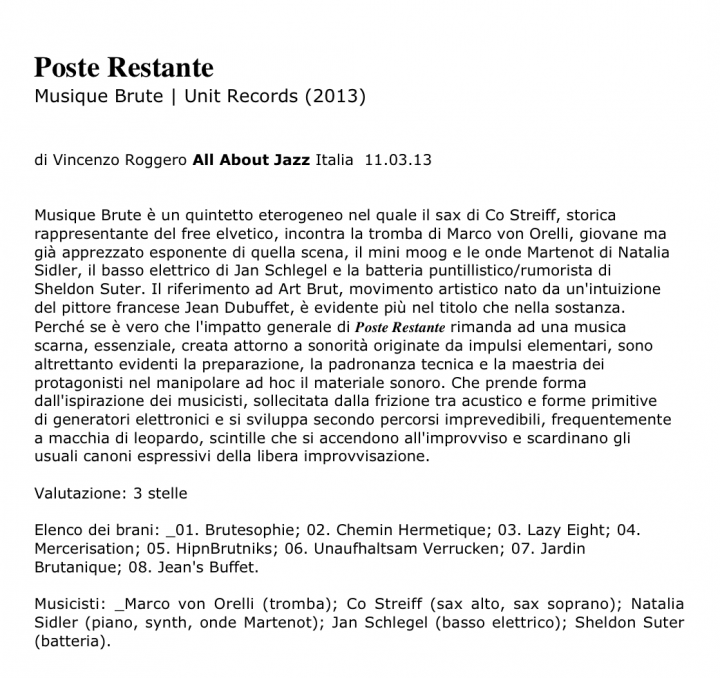
|
Kulturtipp 01/13

|
Jazz’n’More 01/13
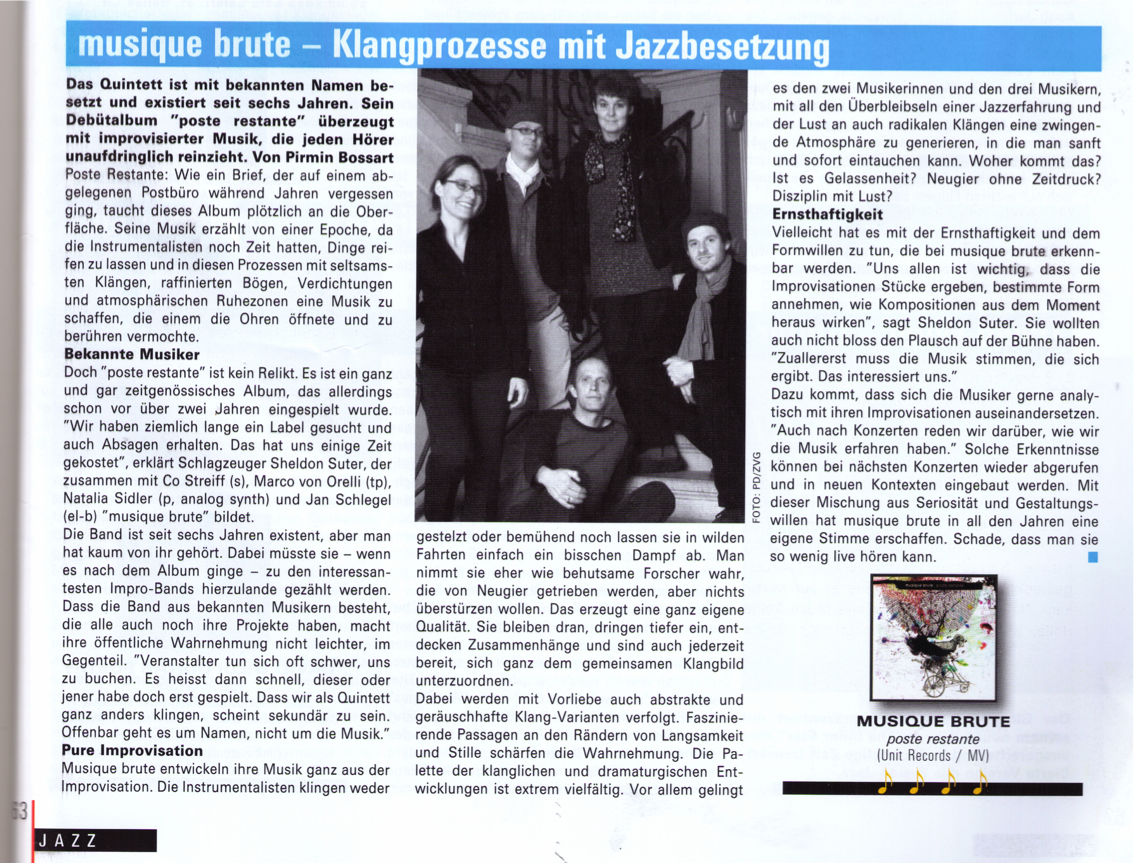
|
| by Christian Carey, Sequenza 21
Swiss trumpeter and composer Marco von Orelli is equally at home in both traditional and “out” settings. Close Ties on Hidden Lanes, a recording of his sextet for Hat Hut, is a snapshot of a band versatile enough to encompass both ends of the jazz spectrum – as well as a healthy dose of contemporary classical reference points – Messiaen, Ives, Scelsi, etc. – to boot. The recording consists of eight originals by von Orelli , which are fleshed out with arranging help from band member and pianist/synth player Michel Wintsch, a performer who isn’t averse to adding electronic rocket fire periodically to the proceedings (listen to the varied and extended cut “Marsala’s Strandgut” for examples). These two are joined by trombonist Lukas Briggen, bass clarinetist Lukas Roos, bassist Kaspar von Grünigen, and drummer Samuel Dühsler. Make no mistake however, even when the group is moving towards post-tonal terrain, they seldom lose track of strong sense of pulsation. On “Urban Ways,” wah-wah trumpets and long drawn out pitch bends are undergirded by a post-bop groove. The rhythm section eventually coalesces in a series of pounding repeated dissonant verticals that recall Stravinsky doing the “Rite thing.” Even in the more free play environment of “Poetry,” in which talking muted brass overtake the rhythm section for an extended period, there is still a sense of urgency and forward drive in the solos. When drums, bass, and keys forcefully reenter, one doesn’t feel as if gears shift, but that the underlying groove has been maintained during their relative absence. A particularly fetching tune which shows off all of the players, as well as von Orelli’s composing chops and imaginative sense of form, is “Narragonia,” a fifteen minute long opus that forms the album’s centerpiece. It embraces long lyrical neo noir solo trumpet and trombone duets, chorale-like tutti passages, and impressively well controlled upper register interjections from Roos. A bracing middle section filled with chromatic coruscation from the piano and terse angular blatting responses from the winds gives way to some avant mayhem from Roos in an extended howling cadenza. Wintsch, von Orelli, and Briggen follow suit, each soloing in equally questing fashion.After the inevitable explosive tutti, we are shifted into a more mysterious soundscape, filled with repeated note filigrees, whole tone piano riffs, and low register glissandi. Another cadenza, this time from trombone, is accompanied by synth, a bit of prepared piano, and alternately shimmering and terse percussion textures. Gradually, von Orelli and Roos reassert themselves, and the opening chorale, deconstructed, lined out, and elaborately ornamented, brings us full circle. The interwoven chromatic lines from the piano and brass interjections reintroduce an even more ecstatic version of the opening chorale, which brings the composition to a tense and dissonant conclusion. Close Ties on Hidden Lanes brings together notation and improvisation, freedom and structure, chamber music and jazz in an amalgamation that suggests vibrant ways forward on each of these musical thoroughfares.
|
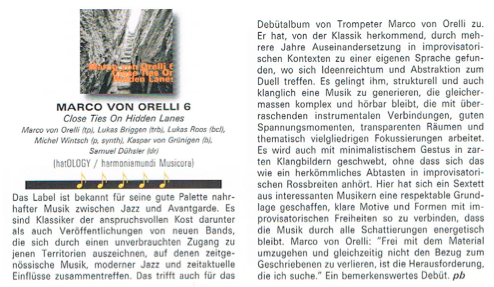 |
| All About Jazz By GLENN ASTARITA, Published: June 6, 2012
Track review of “Urban Ways” Indeed, an impressive inaugural release by Swiss trumpeter Marco von Orelli, who conveys maturity way beyond his youthful age. On call for writing jingles, session gigs, and theatrical productions, the conservatory-trained artist may have a bright future ahead of him, based on the qualitative aspects of this sextet date.”Urban Ways” is a prime example of von Orelli’s cunning musicality, when considering the scope of these multifaceted works. With a pumping funk-groove and contrasting unison horns, the band summons a cheery vibe. Framed on a simple melody line and an upbeat modality, the sextet swerves into a free-form avant-garde sequence, tinted with bizarre electronics swashes and shift gears, encompassing notions of anguish and uncertainty. This pattern continues, as von Orelli injects pathos with his muted wah-wah phrasings and a few slippery detours along the way. The group doesn’t pronounce any semblances of complacency, as pianist Michel Wintschshifts the piece to another zone with his lower-register ostinato phrasings. But von Orelli tosses another curve into the grand schema by faintly altering the primary melody during the coda.Von Orelli is a perceptive young man, signaling a variegated approach to the progressive jazz idiom. And while citing someone as a star in jazz circles may be hindered by a few boundaries since most notions of convention go by the wayside, von Orelli does project star potential on the basis of this striking debut. Personnel: Marco von Orelli: trumpet; Lukas Briggen: trombone; Lukas Roos: bass clarinet; Michel Wintsch: piano, synthesizer; Kaspar von Grunigen: double bass; Samuel Duhsler: drums. Record Label: Hatology |
| Ambitioniert
Marco von Orelli 6: Close Ties On Hidden Lanes. hatOlogy 709. Der junge Trompeter und Komponist Marco von Orelli stammt aus Basel. Studiert hat er in Winterthur, Zürich und in seiner Heimatstadt. Stilistisch bewegt er sich zwischen Jazz, Neuer Musik und freier Improvisation. Das Erbe von Duke Ellington und Charles Mingus ist ihm so präsent wie Schönbergs Zwölftonmusik. In verschiedenen Formationen hat er bereits sein Talent bewiesen: in der Big Band von George Gruntz etwa, aber auch in Tommy Meiers «Root Down». Nun legt er beim renommierten Avantgarde-Label Hat Hut sein Debütalbum als Leader vor. Es ist weit mehr als eine Talentprobe. Die acht Kompositionen faszinieren durch Eigensinn und Ideenreichtum. Sie spielen auf Sebastian Brants «Narrenschiff» (1494) an, dem mit Mitteln der Zweiten Wiener Schule zu Leibe gerückt wird, aber auch auf Man Ray; sie bringen Sizilien und die unterirdische Welt moderner Metropolen zum Klingen. Marco von Orellis Musik ist nicht eingängig, aber nahrhaft. Sie lebt von der Spannung zwischen so knappen wie komplexen, ausgeschriebenen Themen und freier Improvisation. Um solistisches Schaulaufen geht es nicht, wohl aber um subtile Klangfarben-Kombinationen. Dafür sorgen neben dem Leader Lukas Briggen (Posaune) Lukas Roos (Bassklarinette), Michael Wintsch (Piano, Synthesizer), Kaspar von Grünigen (Bass) und Samuel Dühsler (Schlagzeug). |
 |
 |
| There’s much to savour on this debut from Basel trumpeter Marco von Orelli’s sextet, from the wiry lines and multiphonics of trombonist Lukas Briggen to Lukas Roos’s wild bass clarinet, with bassist Kaspar von Gruningen and drummer Samuel Duhsler ensuring the mechanism runs smoothly. Pianist Michel Wintsch deftly counterpoints the horn solos with pockets of activity that perfectly encapsulate the music’s larger harmonic evolution. Orelli’s compositions , like his trumpet playing, are intricately structured and technically impressive without beeing flashy. And it’s not without surprise: love how “ Urban Ways“ moves from M-Base metrics into post-Reductionist splutter without batting an eyelid.
Wire May 2012, by Dan Warburton |
| A beautiful little record – and one of the most compelling Hat Art sets we’ve heard from a younger artist in a long time!
The approach here is quite fresh – initially an interplay of tones and textures, which quickly moves into some rhythmically expressive tunes that push the band forward nicely. There’s then a return to more subtle sound shifts – making great use of piano from Michel Wintsch and bass clarinet from Lukas Roos – then opening up with more lively lines from Marco Von Orelli on trumpet and Lukas Briggen on trombone! Wintsch also plays a bit of keyboards, and the set also features Kaspar Von Grunigen on bass and Samuel Duhsler on drums. Titles include “Marsala’s Strandgut”, “Urban Ways”, “Poetry”, “Narragonia”, and “Maris”. |
|
|
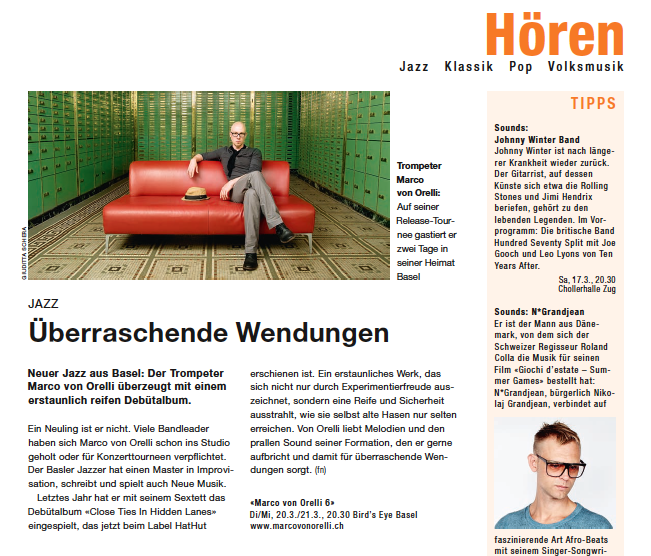
. |
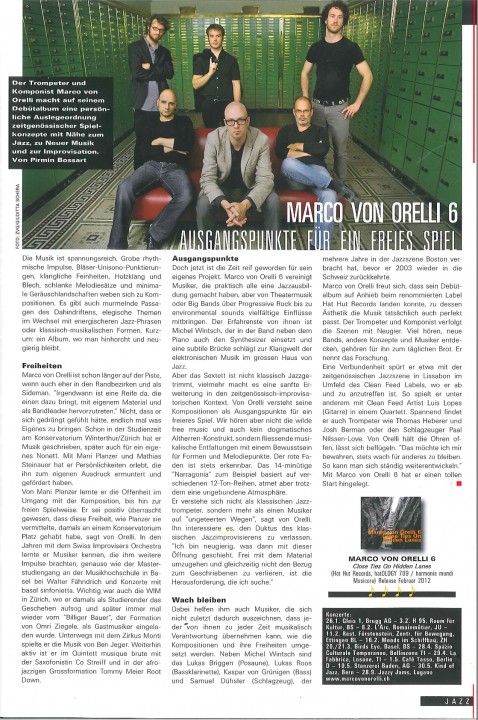
|
